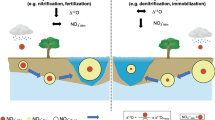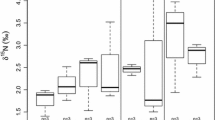Abstract
Nitrogen (N) deposition affects forest biogeochemical cycles worldwide, often contributing to N saturation. Using long-term (>30-year) records of stream nitrate (NO3 −) concentrations at Fernow Experimental Forest (West Virginia, USA), we classified four watersheds into N saturation stages ranging from Stage 0 (N-limited) to Stage 3 (N-saturated). We quantified NO3 − contributions from atmospheric and microbial sources using δ15N, δ18O, and Δ17O of NO3 − and characterized the concentrations and isotopes of NO3 − in precipitation. Despite receiving identical atmospheric inputs, the proportions of atmospheric NO3 − in streams averaged from 7 to 10% in the hardwood watersheds (stages 1, 2, and 3) and 54% in the conifer watershed (Stage 0). This suggests that the hardwood watersheds may be less responsive to future reductions in N deposition than the conifer watershed, at least in the short term. As shown in other studies, atmospheric NO3 − proportions were higher during stormflow. Despite large proportions of atmospheric NO3 − in the Stage 0 stream, total atmospheric NO3 −–N flux from this watershed (2.9 g ha−1) was lower than fluxes in the other watersheds (range = 117.8–338.5 g ha−1). Seasonal patterns of δ15N–NO3 − in the hardwood watersheds suggest enrichment of the soil NO3 − pool during the growing season due to plant uptake. In all watersheds, δ18O-based mixing models over-estimated atmospheric NO3 − contributions to streams by up to 12% compared to Δ17O-based estimates. Our results highlight the importance of atmospheric deposition as a NO3 − source in low-concentration streams and demonstrate the advantage of using Δ17O–NO3 − over δ18O–NO3 − for NO3 − source apportionment.




Similar content being viewed by others
References
Aber JD, Nadelhoffer KJ, Steudler P, Melillo JM. 1989. Nitrogen saturation in northern forest ecosystems. Bioscience 39:378–86.
Aber J, Goodale CL, Ollinger S, Smith ML, Magill A, Martin ME, Hallet RA, Stoddard JL. 2003. Is nitrogen deposition altering the nitrogen status of northeastern forests? Bioscience 53:375–89.
Aber J, McDowell W, Nadelhoffer K, Magill A, Berntson G, Kamakea M, McNulty S, Currie W, Rustad L, Fernandez I. 1998. Nitrogen saturation in temperate forest ecosystems. Bioscience 48:921–34.
Adams MB, DeWalle DR, Peterjohn WT, Gilliam FS, Sharpe WE, Williard KW. 2006. Soil chemical response to experimental acidification treatments. In: The Fernow Watershed Acidification Study. Springer. pp 41–69.
Adams MB, Edwards PJ, Kochenderfer JN, Wood F. 2003. Fifty years of watershed research on the Fernow Experimental Forest, WV: effects of forest management and air pollution in hardwood forests. First interagency conference on research in the watersheds. Benson: USDA-ARS. p 391–6.
Adams MB, Knoepp JD, Webster JR. 2014. Inorganic nitrogen retention by watersheds at Fernow Experimental Forest and Coweeta Hydrologic Laboratory. Soil Sci Soc Am J 78:S84–94.
Adams MB, Kochenderfer JN, Edwards PJ. 2007. The Fernow watershed acidification study: ecosystem acidification, nitrogen saturation and base cation leaching. Water Air Soil Pollut Focus 7:267–73.
Barnes RT, Raymond PA, Casciotti KL. 2008. Dual isotope analyses indicate efficient processing of atmospheric nitrate by forested watersheds in the northeastern US. Biogeochemistry 90:15–27.
Buchwald C, Casciotti KL. 2010. Oxygen isotopic fractionation and exchange during bacterial nitrite oxidation. Limnol Oceanogr 55:1064–74.
Buldgen P, Dubois D, Remacle J. 1983. Principal component analysis applied to nutrient balances in organic layers of beech and spruce forests. Soil Biol Biochem 15:511–18.
Burns DA, Kendall C. 2002. Analysis of δ15N and δ18O to differentiate NO3-sources in runoff at two watersheds in the Catskill Mountains of New York. Water Resour Res 38:9–1.
Campbell JL, Mitchell MJ, Groffman PM, Christenson LM, Hardy JP. 2005. Winter in northeastern North America: a critical period for ecological processes. Front Ecol Environ 3:314–22.
Casciotti KL, Sigman DM, Hastings MG, Böhlke JK, Hilkert A. 2002. Measurement of the oxygen isotopic composition of nitrate in seawater and freshwater using the denitrifier method. Anal Chem 74:4905–12.
Christenson LM, Lovett GM, Weathers KC, Arthur MA. 2009. The influence of tree species, nitrogen fertilization, and soil C to N ratio on gross soil nitrogen transformations. Soil Sci Soc Am J 73:638–46.
Christ MJ, Peterjohn WT, Cumming JR, Adams MB. 2002. Nitrification potentials and landscape, soil and vegetation characteristics in two central Appalachian watersheds differing in NO3 − export. For Ecol Manage 159:145–58.
Coplen TB, Böhlke JK, Casciotti KL. 2004. Using dual-bacterial denitrification to improve δ15N determinations of nitrates containing mass-independent 17O. Rapid Commun Mass Spectrom 18:245–50.
Creed IF, Band LE. 1998. Export of nitrogen from catchments within a temperate forest: evidence for a unifying mechanism regulated by variable source area dynamics. Water Resour Res 34:3105–20.
Deutsch B, Voss M, Fischer H. 2009. Nitrogen transformation processes in the Elbe River: distinguishing between assimilation and denitrification by means of stable isotope ratios in nitrate. Aquat Sci 71:228–37.
Durka W, Schulze ED, Gebauer G, Voerkellust S. 1994. Effects of forest decline on uptake and leaching of deposited nitrate determined from 15N and 180 measurements. Nature 372:22.
Fernandez IJ, Adams MB, SanClements MD, Norton SA. 2010. Comparing decadal responses of whole-watershed manipulations at the Bear Brook and Fernow experiments. Environ Monit Assess 171:149–61.
Galloway JN, Aber JD, Erisman JW, Seitzinger SP, Howarth RW, Cowling EB, Cosby BJ. 2003. The nitrogen cascade. Bioscience 53:341–56.
Gilliam FS, Yurish BM, Adams MB. 2001. Temporal and spatial variation of nitrogen transformations in nitrogen-saturated soils of a central Appalachian hardwood forest. Can J For Res 31:1768–85.
Goodale CL, Thomas SA, Fredriksen G, Elliott EM, Flinn KM, Butler TJ, Walter MT. 2009. Unusual seasonal patterns and inferred processes of nitrogen retention in forested headwaters of the Upper Susquehanna River. Biogeochemistry 93:197–218.
Granger J, Sigman DM, Needoba JA, Harrison PJ. 2004. Coupled nitrogen and oxygen isotope fractionation of nitrate during assimilation by cultures of marine phytoplankton. Limnol Oceanogr 49:1763–73.
Högberg P. 1997. Tansley Review No. 95 15N natural abundance in soil-plant systems. New Phytol 137:179–203.
Kaiser J, Hastings MG, Houlton BZ, Röckmann T, Sigman DM. 2007. Triple oxygen isotope analysis of nitrate using the denitrifier method and thermal decomposition of N2O. Anal Chem 79:599–607.
Kelly CN. 2010. Carbon and nitrogen cycling in watersheds of contrasting vegetation types in the Fernow Experimental Forest, West Virginia. Doctoral dissertation, Virginia Polytechnic Institute and State University.
Kelly C, Schoenholtz S, Adams M. 2011. Soil properties associated with net nitrification following watershed conversion from Appalachian hardwoods to Norway spruce. Plant Soil 344:361–76.
Kendall C. 1998. Tracing nitrogen sources and cycling in catchments. In: Kendall C, McDonnell JJ, Eds. Isotope Tracers in Catchment Hydrology. Amsterdam: Elsevier. p 519–76.
Kendall C, Elliott EM, Wankel SD. 2007. Tracing anthropogenic inputs of nitrogen to ecosystems. In: Michener R, Lajtha K, Eds. Stable Isotopes in Ecology and Environmental Science, Vol. 2. Oxford: Blackwell Publishing. p 375–449.
Kochenderfer JN. 2007. Fernow and the Appalachian hardwood region. In: Adams MB, DeWalle DR, Hom JR, Eds. The Fernow Watershed Acidification Study. Dordrecht, The Netherlands: Springer. p 17–39.
Lovett G, Goodale C. 2011. A new conceptual model of nitrogen saturation based on experimental nitrogen addition to an oak forest. Ecosystems 14:615–31.
Lovett GM, Weathers KC, Arthur MA. 2002. Control of nitrogen loss from forested watersheds by soil carbon: nitrogen ratio and tree species composition. Ecosystems 5:0712–18.
Lovett GM, Weathers KC, Arthur MA, Schultz JC. 2004. Nitrogen cycling in a northern hardwood forest: do species matter? Biogeochemistry 67:289–308.
Michalski G, Meixner T, Fenn M, Hernandez L, Sirulnik A, Allen E, Thiemens M. 2004. Tracing atmospheric nitrate deposition in a complex semiarid ecosystem using Δ17O. Environ Sci Technol 38:2175–81.
Pardo LH, Kendall C, Pett-Ridge J, Chang CCY. 2004. Evaluating the source of streamwater nitrate using δ15N and δ18O in nitrate in two watersheds in New Hampshire, USA. Hydrol Process 18:2699–712.
Pellerin BA, Saraceno JF, Shanley JB, Sebestyen SD, Aiken GR, Wollheim WM, Bergamaschi BA. 2012. Taking the pulse of snowmelt: in situ sensors reveal seasonal, event and diurnal patterns of nitrate and dissolved organic matter variability in an upland forest stream. Biogeochemistry 108:183–98.
Peterjohn WT, Adams MB, Gilliam FS. 1996. Symptoms of nitrogen saturation in two central Appalachian hardwood forest ecosystems. Biogeochemistry 35:507–22.
Prescott CE, Grayston SJ. 2013. Tree species influence on microbial communities in litter and soil: current knowledge and research needs. For Ecol Manage 309:19–27.
Reinhart KG, Eschner A, Trimble GR. 1963. Effect on streamflow of four forest practices in the mountains of West Virginia. Research Paper NE-1. Upper Darby, PA: US Department of Agriculture, Forest Service, Northeastern Forest Experiment Station. 79 p.
Riha K, Michalski G, Gallo E, Lohse K, Brooks P, Meixner T. 2014. High atmospheric nitrate inputs and nitrogen turnover in semi-arid urban catchments. Ecosystems 1–17.
Ross DS, Lawrence GB, Fredriksen G. 2004. Mineralization and nitrification patterns at eight northeastern USA forested research sites. For Ecol Manage 188:317–35.
SAS Institute, Inc. 2011. SAS/STAT user’s guide: Statistics, Release 9.3 edition. Cary, NC.: SAS Institute, Inc.
Sebestyen SD, Boyer EW, Shanley JB, Kendall C, Doctor DH, Aiken GR, Ohte N. 2008. Sources, transformations, and hydrological processes that control stream nitrate and dissolved organic matter concentrations during snowmelt in an upland forest. Water Resour Res 44:W12410.
Sebestyen SD, Shanley JB, Boyer EW, Kendall C, Doctor DH. 2014. Coupled hydrological and biogeochemical processes controlling variability of nitrogen species in streamflow during autumn in an upland forest. Water Resour Res 50:1569–91.
Shearer G, Kohl DH. 1986. N2-fixation in field settings: estimations based on natural 15N abundance. Funct Plant Biol 13:699–756.
Sigman DM, Casciotti KL, Andreani M, Barford C, Galanter M, Böhlke JK. 2001. A bacterial method for the nitrogen isotopic analysis of nitrate in seawater and freshwater. Anal Chem 73:4145–53.
Snider DM, Spoelstra J, Schiff SL, Venkiteswaran JJ. 2010. Stable oxygen isotope ratios of nitrate produced from nitrification: 18O-labeled water incubations of agricultural and temperate forest soils. Environ Sci Technol 44:5358–64.
Spoelstra J, Schiff SL, Hazlett PW, Jeffries DS, Semkin RG. 2007. The isotopic composition of nitrate produced from nitrification in a hardwood forest floor. Geochim Cosmochim Acta 71:3757–71.
Stoddard JL. 1994. Long-term changes in watershed retention of nitrogen. Its causes and aquatic consequences. In: Baker L, Ed. Environmental Chemistry of Lakes and Reservoirs. Washington, DC: American Chemical Society. p 223–84.
Templer PH, Arthur MA, Lovett GM, Weathers KC. 2007. Plant and soil natural abundance δ15N: indicators of relative rates of nitrogen cycling in temperate forest ecosystems. Oecologia 153:399–406.
Templer PH, Lovett GM, Weathers KC, Findlay SE, Dawson TE. 2005. Influence of tree species on forest nitrogen retention in the Catskill Mountains, New York, USA. Ecosystems 8:1–16.
Tiner RW. 1993. The primary indicators method—a practical approach to wetland recognition and delineation in the United States. Wetlands 13:50–64.
U.S. Environmental Protection Agency. 2014. U.S. Environmental Protection Agency Clean Air Markets Division Clean Air Status and Trends Network (CASTNET). www.epa.gov/castnet. Last accessed 21/10/2014.
Williard KW, DeWalle DR, Edwards PJ, Sharpe WE. 2001. 18O isotopic separation of stream nitrate sources in mid-Appalachian forested watersheds. J. Hydrol 252:174–88.
Acknowledgments
This work was supported by NSF Grant #0910521 (to EME) and Agriculture and Food Research Initiative Grant #2012-67011-19663 (to LAR) from the USDA National Institute of Food and Agriculture. We thank Christopher Cassidy for assistance with sample collection and processing, Katherine Redling for isotopic analysis, and the helpful comments of three anonymous reviewers during the preparation of this manuscript.
Author information
Authors and Affiliations
Corresponding author
Additional information
Author contributions
Emily M. Elliott designed the study. Lucy A. Rose executed the field work and data analysis. Lucy A. Rose, Emily M. Elliott, and Mary Beth Adams collaborated on the preparation of the paper.
Rights and permissions
About this article
Cite this article
Rose, L.A., Elliott, E.M. & Adams, M.B. Triple Nitrate Isotopes Indicate Differing Nitrate Source Contributions to Streams Across a Nitrogen Saturation Gradient. Ecosystems 18, 1209–1223 (2015). https://doi.org/10.1007/s10021-015-9891-8
Received:
Accepted:
Published:
Issue Date:
DOI: https://doi.org/10.1007/s10021-015-9891-8




